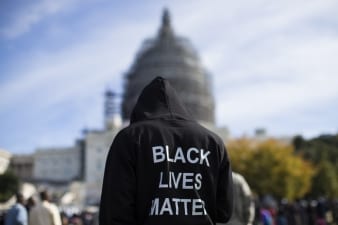JUMP TO:
When Words Fail
October 4, 2016
Nicky Goren
I recently attended a meeting at my temple that focused on Ta-Nehisi Coates’s bestselling book, Between the World and Me—a personal exploration of racial history in the U.S. Members were interested in engaging in a conversation about our role as allies in moving racial equity forward in our community. As attendees raised their hands to contribute to the discussion, I found myself having so much I wanted to say, and yet feeling hampered in my ability to adequately convey my thoughts. While I did speak up, I know I did not have the right words.
And as countless events and tragedies have occurred across the country—from the shooting death of Michael Brown and subsequent unrest in Ferguson, Missouri; the killing of Freddie Gray and the Baltimore uprising; the water crisis in Flint, Michigan; the death of Sandra Bland; the racist undertones evident throughout the presidential race; the ambush resulting in the death of five Dallas police officers; the reactions to Colin Kaepernick’s silent protest of the national anthem; to the recent deaths of Terence Crutcher and Keith Lamont Scott—I have repeatedly found myself at a loss for words.
With each new instance of racial injustice in the media, I have wondered how I and the Meyer Foundation can respond in a timely manner, without being duplicative or redundant, but in a way that adds to the conversation, demonstrates commitment to action, and honors the experiences and feelings of everyone touched by the tragedies we continue to see across this country.
Silence Speaks Volumes
While I don’t always know exactly what to say to add value to the conversation, I know that I, and the foundation I represent, cannot purport to be partners in tackling our region’s deepest challenges without addressing the systemic racism that is deeply rooted in so many of the issues we are working to fix today.
We live in a country and in an era where racism, inequity, and injustice persist. Racial disparities play out in housing, median incomes, educational attainment, health outcomes, and so much more. For some Americans, centuries of bias, discrimination, and xenophobia have been elevated as topics of discussion for the first time. And for some Americans, the wait for the rest of the country to catch up on those topics has been far too long.
While the Meyer Foundation has a history of addressing race relations in the Greater Washington region—particularly in the late 1950s and 1960s—we recognize that in these ongoing times of racial turmoil we cannot simply rest on the achievements of the past. We understand the causal relationship between systemic racism and poverty. And we know that we can no longer use our struggle to “find the right words” as a valid reason for Meyer to remain silent on the issues that continue to affect so many.
A Time for Clarity
Darren Walker, the president of the Ford Foundation, has pointedly posed the question: “Are we using our privilege to compound our privilege? Or are we using our privilege to call out the things that are wrong and unfair and unjust in our society?” We have taken these questions seriously.
After gathering input from many stakeholders through our strategic planning process, we determined that we needed to strengthen the Foundation internally in order to influence and affect change externally. Last year, we released the Meyer Foundation’s new strategic plan and signaled our commitment to advancing racial equity in our work across the region.
We conducted an organizational assessment to identify priority areas for growth and focus. Our board and staff engaged in training to build common language and understanding that could enable more authentic and deeper dialogue about how we then incorporate this learning into our everyday lives and work. We launched internal working groups to begin identifying what success would look like if we incorporated an equity lens into our programs and operations, from our grantmaking decisions to how we hire staff, vendors, and consultants. This work led us to begin developing our vision and stance on racial equity, in a document we hope to share later this year.
This vision and stance continue to evolve. While they need further development and community input, we are certain that our ultimate goals are to undo persistent, racialized social and economic disparities in our region, and to build an organizational culture that encourages us to challenge our own assumptions and biases so that we can continuously improve our policies and practices as we work to advance equity.
Standing Together
This has been no small task. I am grateful for the many partners the Foundation has had on this ongoing journey. I am also encouraged by the work being done in our region—from the Washington Regional Association of Grantmakers’ Putting Racism on the Table series to the opening of the long-awaited National Museum of African American History and Culture.
While I remain hopeful, I am also deeply saddened by the lives of daughters, sons, mothers, fathers, friends ending in hashtags across social media. I reject the notion that simply being able to proclaim the indisputable—that black lives matter—remains controversial and debatable for some. And I know that many in our community are even more distressed by injustices experienced every day.
I see you. We see you. And we hear you. As an institution and as individuals, we continue to learn how to better communicate on these issues. We are listening closer to find the right words, and we are committed to turning them into action and working alongside those of you who have long been steeped in these issues and in this work. Together we can build an equitable Washington region.

